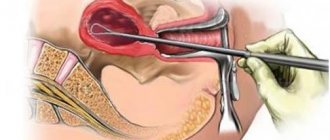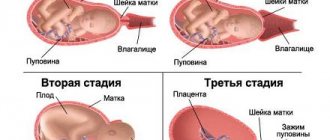Many expectant mothers, especially those pregnant with their first child, worry about childbirth. The unknown is scary
, thoughts about painful contractions or negative experiences of the first birth.
In a series of articles about optimal behavior during different periods of labor, we will describe in detail all stages of the birth process and give clear recommendations for each of them. Knowledge is power! After reading this information, you will know what to do at different stages of labor
. You will feel confident and calm, because childbirth is a wonderful, natural and healthy process!
I will become a mother - IVF, planning, pregnancy, childbirth and after childbirth
There can be many reasons why there are no contractions at 40 weeks. Not all of them are pathological. So, sometimes the gestation period is slightly extended due to long-term use of magnesia, a drug used up to 36 weeks to maintain pregnancy with high uterine tone. Magnesium sulfate (magnesium) relaxes smooth muscles. By the way, it also has a “side effect” - it lowers blood pressure well and reduces edema, which can play an important role during childbirth.
Interesting: Can You Drink Sage During Your Period?
Due date
Gestation time is an individual value. It depends on several factors:
- number of births;
- genetic predisposition;
- mother's age;
- hormonal levels;
- cycle duration;
- dates of fertilization.
Perhaps the expected date of birth was not calculated accurately enough, or the individual characteristics of the body are such that the baby will be born a little later. There is nothing wrong with this, if only because the optimal period is 37-42 weeks. Statistically, women pregnant with their first child give birth later than multiparous women. About 9% of first-time mothers carry the fetus to term and give birth after 42 weeks. If a woman is having her second birth, at 40-41 weeks of pregnancy the doctor may decide to induce labor.
Post-term babies - what are they like?
In a post-term fetus, the bones of the skull become dense, the seams between the bones become narrow, and the size of the fontanelles decreases. These phenomena cause birth injuries, since the dense bones of the skull cannot move relative to each other and take the desired configuration when passing through the relatively narrow birth canal.
Interesting! Natural birth after caesarean section
For mothers whose babies were born post-term, it is useful to know several important points about caring for a newborn:
1 Baby skin care.
The skin of a post-term baby requires special care. As a rule, it is dry and prone to irritation.
Therefore, the baby’s skin must be periodically gently wiped with oil. For these purposes, it is better not to use popular synthetic-based “baby” oils.
Natural oils, such as grape seed, peach, and wheat germ, are best suited.
Carefully monitor your child’s hygiene, wash him every time before changing the diaper.
This should also be done as carefully as possible: make sure that diaper rash does not occur between the folds, and gently blot the skin with a napkin or diaper.
Allow your baby to be out of diapers or diapers more often. It is important for the skin to “breathe”. This is necessary in order to avoid irritation or diaper rash.
2 Care for the fontanel.
The fontanel in post-term babies may close faster than in children born at term. For parents, this phenomenon should not become a cause for concern.
In this case, there is no need to stop taking vitamin D, which is prescribed to newborns for proper bone growth, unless indicated by a pediatrician.
The baby must be shown to a neurologist in a timely manner to undergo neurosonography (ultrasound of the brain).
3 Nutrition problems.
Nutrition for babies born after term is somewhat different from usual. Sometimes post-term babies are born with intrauterine malnutrition. This is a problem caused by the aging of the placenta: the blood vessels of the placenta cease to perform their functions and supply sufficient nutrients to the fetus.
This disorder is characterized by the child’s weight being less than normal. But this problem is not very serious, and it can be easily corrected in the first months of the baby’s life.
It is advisable to feed such children with mother's milk. It is necessary to put the baby to the breast strictly on demand, and it is best to avoid long breaks between feedings.
How to recognize the onset of labor
Many women, especially during their first pregnancy, are most afraid of missing the onset of labor and not being able to get to the maternity hospital on time. According to obstetricians-gynecologists and experienced mothers, it is almost impossible to miss the onset of labor. But the assurances of doctors and friends who have given birth do not always help relieve anxiety, so let’s figure out what signs signal the onset of labor, and how to understand that it is really time to go to the maternity hospital.
Harbingers of childbirth
There are several indirect signs that indicate that labor is about to begin. They are called “harbingers of childbirth.”
Abdominal prolapse
- What's happening?
The most protruding point of the abdomen goes down, but its circumference does not become smaller. The expectant mother's breathing becomes easier, but the urge to urinate, on the contrary, may become more frequent.
- Why is this happening?
The baby is inserted with its head into the birth canal - it is ready to be born. It no longer rests on the diaphragm and ribs, the child's head presses on the bladder and rectum.
- How long before giving birth?
It’s difficult to say exactly – from several days to several weeks.
- Is this an accurate sign?
Not really - when the head is inserted into the birth canal, the external shape of the abdomen may not change. And in multiparous women, the most convex point of the abdomen can be directed downward from the very beginning of its growth.
Removal of the mucus plug
- What's happening?
A clot of mucus is released from the vagina. It can be of different colors, from white to yellow-brown or reddish, and come out whole or in parts.
- Why is this happening?
Before childbirth, under the influence of hormones, the cervix begins to shorten and soften to make it easier for the baby to be born. The mucus plug, which previously tightly closed the entrance to the cervix to prevent germs and bacteria from entering, simply falls out.
- How long before giving birth?
Most likely, not very much, from several hours to several days.
- Is this an accurate sign?
Yes, this is a fairly accurate sign showing that the mother’s body is ready for childbirth.
Training or false contractions
- What's happening?
You feel irregular contractions that make your stomach hard. Closer to the beginning of labor, they become more noticeable than before, but their duration does not increase.
- Why is this happening?
The muscles of the uterus prepare for childbirth, its lower part stretches, the cervix softens, but does not open yet.
- How long before giving birth?
Probably from several hours to several days.
- Is this an accurate sign?
More likely yes than not, but if you felt strong Braxton Hicks training contractions in the 2-3 trimester, you may not feel that anything has changed.
Rush of amniotic fluid
- What's happening?
A fluid is released from the vagina, the color of which can be either transparent or greenish or pink. The water does not always pour out at once, as they like to show in the movies; before the contractions begin, they can simply leak.
- Why is this happening?
The membranes of the fetal bladder rupture or tear and the amniotic fluid comes out through the cervix. Contractions may not be felt or may be very weak.
- How long before giving birth?
Just a few hours. Pay attention to the color of the water - if it is clear, you can calmly pack your things and go to the maternity hospital on your own. If the waters are green or there is a lot of blood in them, call an ambulance immediately.
- Is this an accurate sign?
Yes, sure. If you are 36 weeks or more pregnant, your baby is due soon. It is not advisable for the baby to be in an anhydrous period for more than 12 hours, and if labor does not begin on its own, the doctor may offer you stimulation. If you are less than 36 weeks pregnant, call 911 immediately.
How to distinguish real contractions from false ones
Increasing frequency and intensity
If you notice that the interval between contractions is getting shorter, go to the maternity hospital. During the first birth, many hours can pass from the onset of contractions to the birth of the baby, in some cases even more than a day. So, if the interval between contractions is more than 7 minutes, and the contraction itself lasts less than 1 minute, you have time to calmly collect your things. With the second and subsequent births, it is better to hurry; with each subsequent pregnancy, the likelihood of a rapid birth increases.
Soreness
If during false contractions there was no pain at all or it was very weak, then during real contractions the pain is noticeably more intense. Moreover, the pain will increase along with the frequency of contractions.
Other signs
Lower back pain or spotting from the vagina only appears during real contractions. Real contractions may also be accompanied by chills or shaking.
How to count contractions?
To arrive at the maternity hospital not too late and not too early, you need to count the contractions. Find an online contraction calculator program on the Internet or download it to your smartphone. Or you can use paper, a pencil and a stopwatch or a watch with a second hand the old-fashioned way. In any case, your task is to mark the beginning and end of each contraction. If the onset of contractions finds you at home, ask someone in your household to record the duration of contractions and the intervals between them, and just rest before giving birth.
When to go to the maternity hospital?
If you feel one of these signs or several at once, consider that you need to be in the maternity hospital within 1-2 hours:
- Rush of amniotic fluid
- Reducing the interval between contractions to 5 minutes
- Increasing the duration of the contraction to 45-60 seconds
- Intense pain in the lower back, felt with a certain frequency (these are also contractions)
- Increasing pain in contractions to the point where you can no longer comfortably carry on a conversation
According to statistics, most babies in natural childbirth are born in the morning or early afternoon. From this we can conclude that the onset of labor often occurs at night or early in the morning. Be especially attentive to your feelings at this time of day. However, at any time of the day or night, if you suspect that labor has begun, it is better to go to the maternity hospital and see a doctor again.
Signs of post-term pregnancy
These signs are determined by a specialist during an ultrasound:
1 A decrease in the amount of amniotic fluid indicates both post-maturity and the fact that the woman is likely to experience weak labor.
2 Immaturity of the uterus at 40 weeks and above;
3 Absence of a flat bladder (the protective shell of the baby’s head). This factor also influences the onset and duration of labor;
No particles of cheese-like lubricant were observed in the amniotic fluid , which protects the skin of the fetus;
5 Cloudiness of the amniotic fluid indicates that the fetus does not have enough oxygen. In such cases, early delivery is prescribed.
Childbirth positions
It must be said that it is very important for a woman to have freedom of movement during childbirth. Usually a woman in labor intuitively feels how she needs to sit or stand to relieve labor pain. Therefore, do not hesitate to take positions in which you are most comfortable.
There are several most correct generic positions:
- Get on all fours and lean forward slightly. Rock from side to side and make circular movements with your pelvis.
- While kneeling, lean forward and lean on the bed or chair.
- A large gymnastic fitball is an excellent “simulator” during childbirth. You can sit on it, lie down, or rest your hands on it, kneeling and lowering your stomach.
- Squat down and spread your knees wide. This position allows you to relax your pelvic floor muscles. A partner can take you into this position; he should hold you from behind while you lower your pelvis as deeply as possible.
- Sit on the edge of a chair facing the back, spread your legs wide and relax your pelvic muscles. In this position, you can sit on a stool, hugging your partner.
- Constantly stroke your lower abdomen with your open palm.
- Rub your sacrum. It is better to use special massagers; they have a stronger targeted effect and protect your fingers or your partner’s fingers.
What to do if contractions don’t start?
It depends on each specific situation. If there is no threat to the baby, the pregnancy may continue. In this case, to stimulate labor, women are recommended:
- having sex (before the mucous plug comes out, after it comes out, sex is not recommended to avoid infection of the fetus);
- nipple stimulation;
- walking, going up and down stairs;
- castor oil in a small amount (a few drops) orally to stimulate intestinal motility, which causes uterine contractions.
In some cases (with immaturity of the cervix), during full-term pregnancy (at 40-41 weeks), one of the antigestagenic agents (Mifepristone, Miropriston, Genele, Ginestril) at a dose of 200 mg/day can be prescribed to induce labor activity, taken every other day medications are repeated in the same dose. 3 days after taking the first tablet, the doctor assesses the condition of the birth canal.
If stimulation does not help, a decision may be made to perform operative delivery. If the waters have broken, but labor has not begun, you need to get to the maternity hospital as early as possible so that doctors can find out the reason for the early rupture of waters and take measures to successfully resolve the birth.
Should I shave my perineum before giving birth?
No, this is no longer a mandatory requirement. But there are cases when maternity hospital staff do not welcome or simply ignore such innovations, especially for “old-school” midwives. However, a woman has every right to make her own choice in this matter.
There are times when pre-shave is really necessary. For example, if an episiotomy (an incision in the perineum) is performed during childbirth or the perineum ruptures on its own. The resulting wound must be sutured in layers. The last layer is the skin with hair follicles. It is very difficult for even the most professional surgeon to beautifully and accurately match the edges of the skin, and even more so, skin with increased hair growth. After surgery, the woman herself may experience an unpleasant feeling of “tightness” in her hair, since it will actually stretch. In addition, these same hairs can begin to grow into the skin and even fester in the wound.
Therefore, just in case, contact the doctor who will deliver the baby with the issue of shaving the perineum.
Breathing during childbirth
In the initial stage of labor, you can breathe deeply, relaxed and calmly, that is, almost the same as usual. At the stage of strong contractions, slow and deep breathing will no longer provide relief, so it should be slightly modified.
Breathing during the most intense contractions can be imagined as a smooth wave. At the beginning of the contraction, you breathe slowly and deeply, and as the compression of the uterus increases, you switch to rapid, jerky breathing. Moreover, you need to breathe with your mouth open, “like a dog.” It is important to focus your efforts on quick, regular exhalations. At the end of the contraction, when the pain subsides, breathe slowly again.
Don't lose your breath. At the peak of the contraction, breathe deeply and freely. Inhale through your nose and exhale through your mouth.
Fetal development at 41 weeks of gestation
By this time, the fetus is fully formed and ready for birth. The basic systems are at a level that is sufficient to begin functioning in the outside world. His nervous system continues to improve, but it will continue to develop after the child is born.
If labor does not begin at 37-40 weeks, the baby continues to grow and accumulate 30 grams of fat per day. Fetal growth during this period averages 50-52 cm, weight from 3.5 kg. Its activity is noticeably reduced due to lack of space. But the mother should feel up to 10 movements in ½ hour. If fetal movements freeze, you should consult a doctor.










